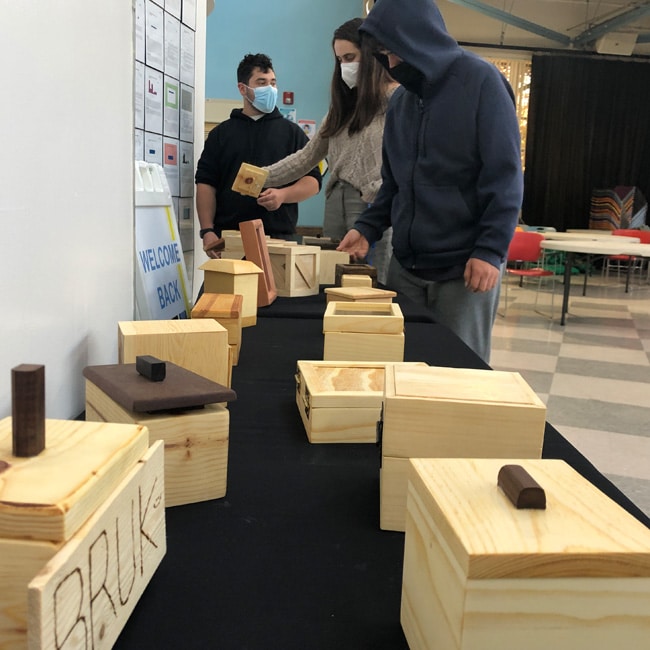Menu
Could you do this? Build a wooden box. Constrain any and all dimensions, whether length, width or height, to 5.5 inches. Avoid hinges in designing lids on the boxes. Oh, and plan to build all knobs, pulls, handles and the like yourself.
Students at the Gary and Jerri-Ann Jacobs High Tech High tackled this project and more to familiarize themselves with the design process from ideation to fabrication. The teaching team of 11th grade humanities teacher Mr. Pat Holder, and 12th grade environmental science teacher Mr. John Santos, are growing students’ learning through woodworking. Building a wooden box is a precursor to building wooden furniture later in the semester.
“While we don’t often pay them much attention, boxes are everywhere around us,” noted Mr. Holder, in his overview to students about the project. “Mail boxes, tool boxes, Amazon boxes, pizza boxes, moving boxes and many other boxes, each with a pretty specific purpose, move in and out of our lives.”
Students started by learning to safely and effectively use woodworking equipment. And in building a culture of collaboration, they asked questions while learning craftsmanship, critiquing and revising their work and the work of their peers. “The whole goal was not to build the best boxes but to learn the tools of the design process,” Mr. Holder said.
Student Belen Perea says this about the “Build a Box” project, “I always found woodworking and working with my hands fascinating. When we were able to bring the designs that we made to fruition, make a box with our own two hands, sand it, and be able to look at it in real life—bringing a concept to life is actually amazing.”
The hands-on work in Mr. Holder’s and Mr. Santos’ classrooms may appear similar to what generations past called woodshop classes. To be clear, what’s taking place at HTH is not your grandfather’s woodshop class. Future architects, engineers or mathematicians are as likely to emerge from these classes as craftsmen (or craftswomen).
Indeed, the HTH classrooms run counter to what has occurred over the last few decades across the country, as hundreds of public schools curtailed or completely eliminated vocational and/or career technical education courses. Since its beginning, High Tech High intentionally designed its curriculum to bring together the best of a traditional academic education and career technical education.
Students like Belen are as comfortable handling power tools as they are with the creative design process. Consider some of the students’ written reflections:
“When I build furniture, I’m not going to settle for a simpler version. I’m going to put much more effort into making a design that excites me, and planning exactly how I’ll make it happen.”
“As you get into the build, let your ideas run and experiment, so you can create something you want!”
Mr. Santos notes that exploring the sciences with his students is one of his strongest passions and that project-based learning is fundamental to his teaching philosophy. It seems second nature for his biology students to take on existential exploration of the question, Why does furniture exist?
“We gravitate towards this idea that the experiences that kids have inside a classroom need to connect overtly and explicitly to the content that you’ve been tasked to teach,” Mr. Santos said. “I would argue that there’s a lot of skill sets that happen outside of that content area that are very healthy for students to develop. By setting in motion a process like building boxes together, you are building this ability to conceptualize, to plan, to collaborate. To build something, and then look at the piece and reflect on it …has this value that spills into the rest of the learning. This for us is a process, an iterative cycle …where students build something they can be proud of but where they also gain a sense for what they might do differently next time, and how they are going to grow as learners.”
Follow the students and their progress on Instagram @furnitureexists. The furniture they make will be sold at the end of the year as a fundraiser.
Tags:




